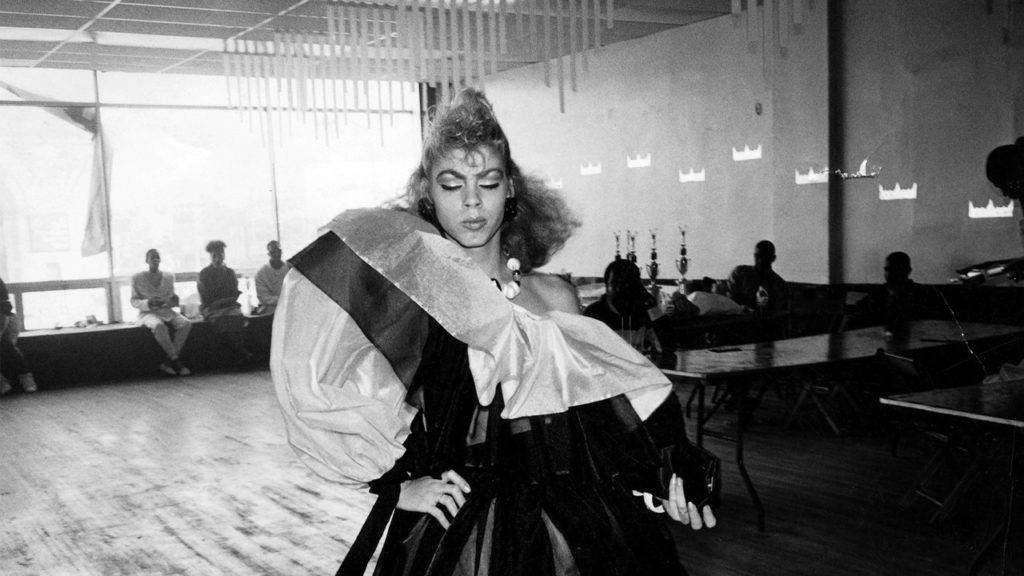Paris is Burning

“We all have at one time or another lusted to walk a ballroom floor. So give the patrons a round of applause for nerve. We’re not here to be shady, just fierce.” -Junior LaBeija
From the bars and bath houses of Montmartre of the Belle Epoque to Manhattan’s Hamilton Club in the 1920’s, the metropolitan underbelly celebrated and, at times, sheltered the queer community. After the riots in Paris and Stonewall, between 1968-69, the disco era nourished the parched roots of ball culture. Once again, the club scene of lower Manhattan thrived.
By 1990, the ethos of excess manifest in a timely convergence of musicians, fashion designers, and celebrity, in the heart of New York culture, found itself appropriated by pop icon Madonna—her twelfth number one single heralding, ex post facto, the aggressive dance style named for Vogue Magazine. By then, everyone wanted to co-opt the scene’s popularity for their own purposes including, arguably, Jennie Livingston—director of PARIS IS BURNING.
With grants from the National Endowment for the Arts, support from her relatives (including her uncle, producer Alan J. Pakula), and numerous other donors, Livingston’s provocative documentary explores the underground drag ball culture of Manhattan in the late 80’s. Filmed from 1987 to 1989, the movie peers inside the lives of Dorian Corey, Pepper LaBeija, Venus Xtravaganza, Octavia St. Laurent, Paris Dupree, and Willi Ninja, among others.
In the intervening years since its release, queer cinema fractured into gay, lesbian, and transgender sub-genres. The seeds of division are evident in PARIS IS BURNING, but only in the accounts themselves and not necessarily the filmmaker’s omniscient—some would say voyeuristic—bent. Even then, Pepper’s opinion of sexual reassignment isn’t motivated so much by a disdain for his peers. Being a woman, he argues, has a greater social cost than holding on to the privilege of being male. The modern aspirational context of ball culture arises out of a need to escape poverty, if only mentally.
Widely regarded as ground-breaking not for its style, but its content, Livingston’s documentary ignores these abstractions, focusing on the shared experience of marginalized youth—beginning and ending with a couple of boys who perceptively understand the concept of “found family” better than most adults.
Studies have shown that the working poor experience a much higher rate of mental and physical illness aggravated by the stress of operating in a constant survival mode. The NIH finds that poverty impairs cognitive development, and this can only be worse for marginalized groups¹ who face significant social and economic barriers.
“You like it. The adulation. The applause. It’s a good high… an addictive high. But it’s a good high—a high that won’t hurt you.” -Dorian Corey.
Categories in drag ball culture manifest from a desire to “pass”—e.g. a gay or trans person passing as a cisgender heterosexual. These include Upcoming Pretty Girl, High Fashion Sportswear, Miss Cheesecake, Luscious Body, Schoolboy/girl Realness, Town and Country, Executive Realness, High Fashion Eveningwear, Military. Rather presciently, ball culture foresaw the American conflation of celebrity and fashion. As Corey notes, categories emerged in which the objective was to emulate the look of particular characters from television programs, like Dynasty. Hollywood celebrities have replaced the supermodels of the 90’s on the covers of Vogue, Cosmopolitan, and the like.
Performative femininity is in some ways a reaction to performative masculinity. As long as society continues to place constraints on gender expectations and societal roles, countervailing movements will push back. That defensiveness erupts as a “read”. Reads directed at one another in the same community are “shade”. As Corey puts it, “Shade is: I don’t tell you you’re ugly. But I don’t have to tell you because you know you’re ugly.”
Willi Ninja, one of the pioneers of voguing, describes it as a fight without weapons. The hand acts like a compact mirror, and when turned around it confronts the opponent—as if holding up a mirror to their face. Founding the House of Ninja in 1982, by the end of the decade others took notice of his pioneering moves. Pop culture influencers took note. Impresario Malcolm McLaren, producer of glam and punk innovators, the New York Dolls and Sex Pistols, hired Ninja as a performer and choreographer.
But in the broader mass media, none of the queer underpinnings ball culture took root. Though fixation on celebrity culture pervaded, Voguing came and went. Christmas 1988, Venus Xtravaganza’s body was found by the Duchess Hotel—strangled to death. In the decades following Bernie Goetz, HIV/AIDS and the Central Park Five, New York seemed at last determined to pave over every last vestige of cultural diversity. One by one, clubs from 54 to the Palladium to CBGB shut down. Even the Roy Rogers next to Penn Station, frequented by “stunters” (shoplifters), is gone. If ball culture was the queer, brown community’s answer to poverty, gentrification was the straight, white community’s solution—erase the poor entirely.
“When they’re undetectable, when they can walk out of that ballroom, into the sunlight and onto the subway and get home and still have all their clothes and no blood running off their bodies, those are the Femme Realness queens.” – Dorian Corey
- Transgender individuals are four times likelier than the average person to have a household income below $10,000, and twice as likely to be unemployed. As many as one in five are homeless. (Sources: National Transgender Discrimination Survey; Williams Institute, UCLA School of Law).